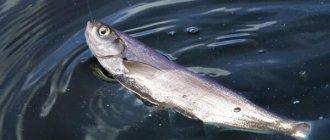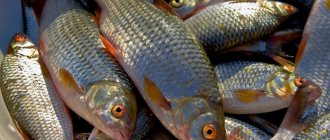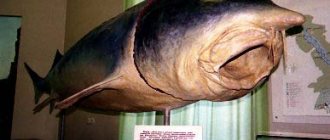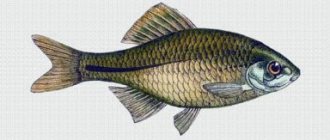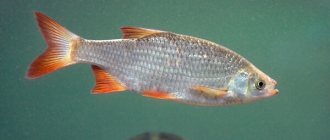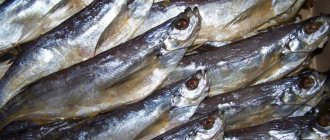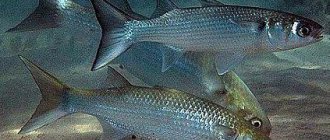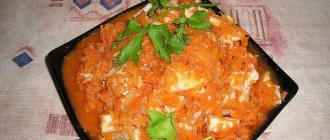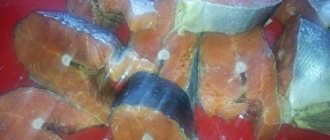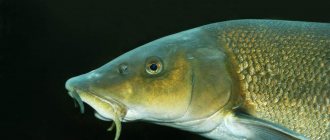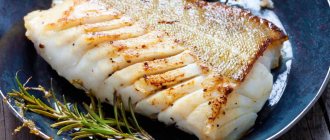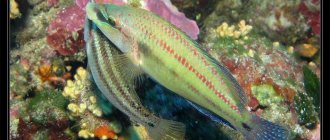Description
Silver crucian carp is a fairly well-known fish, which at one time spread from the Amur basin throughout almost all of Eurasia. The object of amateur fishing has commercial significance.
External signs
Medium sized fish. It has a short, laterally compressed body, less tall than that of the goldfish. The number of scales in the lateral line is from 27 to 31. The gill rakers are long, their number is from 39 to 50. They are flexible and can form variations in color and some other external characteristics.
The scales of the goldfish are gray-silver, with a slightly dark, bronze-greenish back. Sometimes you come across individuals with a pronounced yellow tint, almost indistinguishable from golden crucian carp.
Dimensions, weight
Typically, catches contain specimens up to 20 centimeters long, weighing no more than 350 grams. The maximum size that crucian carp can reach under favorable conditions is approximately 40 cm in length and weighs up to 2 kg.
Despite the fact that silver carp is usually smaller than gold carp, it grows faster than the latter.
Similar fish
A related species, golden crucian carp, has much in common with silver crucian carp. Also similar to it are representatives of the Chukuchan family, for example, largemouth, smallmouth and black buffalo, which differ from crucian carp by a more pronounced notch on the dorsal fin.
Young fish of the scaly form of carp also resemble silver crucian carp in appearance; they can be distinguished from the latter by the presence of antennae and a more elongated muzzle.
Anatomical features
The pharyngeal teeth are double-rowed, 4 on each side. The length of the intestine is approximately twice the length of the body.
Habitat
Once upon a time, silver crucian carp inhabited the Amur basin. In the second half of the last century, they began to release it into Siberian and European reservoirs. Thanks to its unpretentiousness and ability to spread independently, crucian carp has expanded its range, covering almost all of Eurasia. There is also a version that it appeared in Europe during the Middle Ages - when it was brought from China.
Habitats
It is found in both stagnant and flowing reservoirs, and thrives in rivers, including estuary areas flowing into the sea. Sometimes it displaces the local golden crucian carp from inhabited reservoirs, to the point of its complete disappearance. In some others, she gets along calmly with him.
Where does crucian carp live?
The habitat of crucian carp is very extensive. Populations of silver and golden carp live both in the clean waters of rivers and lakes, and in swampy natural and artificial reservoirs and ponds overgrown with vegetation. The only places where fish are not found are mountain lakes and rivers.
As a result of human economic activity, crucian carp live in the reservoirs of Poland, Germany, Italy and Portugal, Hungary, Romania, Great Britain and Belarus, Kazakhstan and Mongolia, China, and Korea. These fish are also fond of the cold waters of Siberian rivers and lakes; crucian carp are also caught in Kolyma and Primorye. Today, representatives of the genus live in Thailand and Pakistan, the United States of America, India and many other countries.
When unfavorable conditions occur (drought or severe frosts), crucian carp are able to wait them out by burrowing into muddy soil to a depth of 0.7 m.
Lifestyle
Usually crucian carp stays near the bottom or in thickets of underwater vegetation. It can rise to the upper layers of water, for example, during a period of mass emergence of insects. Forms schools; large fish can stay alone. It is unpretentious to the quality of water; in case of unfavorable conditions (drying out or freezing of the reservoir, low oxygen content in the water), it buries itself in the silt and hibernates. It can remain in this state for quite a long time.
Daily and seasonal activity
In different reservoirs, the daily activity of crucian carp is not the same. It is usually active in the morning and evening hours, but in some ponds and lakes it can only feed at night. This especially applies to those reservoirs where crucian carp have to share habitats with predatory fish.
Among other things, daily activity is influenced by weather conditions. For example, in the summer heat, crucian carp can feed only in the morning, when the water temperature in the reservoir is minimal, and in cloudy and cool weather - throughout the day.
The seasonal activity of crucian carp depends on the conditions in the reservoir. In flowing ponds and reservoirs with good oxygen conditions, crucian carp can be active all year round. In stagnant lakes, where oxygen starvation is likely in winter, crucian carp will most likely go into hibernation. It can also hibernate in the middle of summer - if the body of water in which it lives warms up well. A strong bloom of water caused by phytoplankton can also force crucian carp to reduce activity. On rivers, crucian carp are usually active all year round.
Migrations
Silver crucian carp leads a predominantly sedentary lifestyle, but during spawning it is quite capable of leaving lakes for tributaries and ascending rivers.
Natural enemies
Fish such as perch, pike perch, pike and burbot feed on small specimens of crucian carp. Among other animals, crucian carp is attacked by snakes - the common snake and the viper. When crucian carp feeds in shallow water or closer to the surface of the water, it is hunted by fish-eating birds - gulls, terns, and grebes.
Large crucian carp can be caught by heron and osprey, as well as predatory mammals - mink and otter.
Nutrition
- Personality: omnivore.
- Objects: aquatic and semi-aquatic invertebrates, insects and their larvae, algae, higher plants, detritus. Unlike golden crucian carp, plant foods and planktonic crustaceans are of greater importance in the diet of silver crucian carp.
- Seasonal preferences: in the cold season it prefers animal food, the rest of the time it is omnivorous.
- Prey sites: in ponds and lakes, these are muddy areas of the bottom, or areas near the banks with thickets of semi-aquatic vegetation, where crucian carp scrape settled detritus and invertebrates from the stems. When a fish feeds in such places, it usually makes its presence known with characteristic smacking sounds. In rivers, crucian carp stay in stretches with moderate or slow currents. Thickets of underwater plants, as well as the mouths of tributaries and bushes hanging low over the water - all this also attracts crucian carp.
Spawning
- Age of sexual maturity: 2-4 years.
- Required water temperature: 13-15 °C.
- Spawning grounds: areas of the bottom overgrown with plants.
- Nature of spawning: usually portioned, but in some steppe reservoirs the eggs can be spawned in one go.
- Features: female goldfish are capable of gynogenesis - reproduction without the participation of males of their species. The essence of this method is that silver crucian caviar can be fertilized by the milk of other carp fish (carp, carp, tench, golden carp). In this case, full fertilization does not occur - the eggs are only stimulated to develop, and all the larvae that hatch from it are genetic copies of the female that laid the eggs. Because of this, in some reservoirs the population of crucian carp may consist entirely of females.
- Period (for the Middle Urals): second half of May - beginning of June.
Lifestyle of crucian carp
Crucian carp is most often found in waters where there is either no current at all, or it is barely noticeable. Despite this, this type of fish does not lead a sedentary lifestyle. On the contrary, it makes constant migrations to find a new source of food or a place for spawning.
Experts say that movements for the purpose of reproduction in this fish are the most extensive. At the same time, the crucian carp goes up the river, reaching dams and spills, where spawning occurs. Already with the onset of summer, the flocks return back to their permanent habitats.
Often fishermen have to resort to using non-standard flavorings: anise drops or garlic.
In the summer, the fish becomes more capricious: it switches to plant foods and becomes quite picky in terms of bait. During this period, adult representatives and young animals spend more and more time hiding under a thick layer of silt. Only in the early morning or at night do they approach the shores to feed.
The flocks begin to move away from the banks and stick mainly to deep holes. Some fishermen claim that in winter, this fish burrows deep under layers of silt and goes into hibernation mode. In fact, you can even catch crucian carp, because it will be found closer to warm zones: for example, to the discharge of heat sinks.
Crucian carp, as a fish, forms the basis of the “population” of most standing and flowing water bodies in its habitat. It thrives in both small ponds and swamps and large rivers, including estuaries and freshwater deltas. Moreover, crucian carp prefers muddy, silty places, but it does not like reservoirs with crystal clear water and a rocky bottom. For this reason, it is almost impossible to find in mountain lakes, rivers and streams.
Crucian carp is completely unpretentious to the quality of water, and if the conditions in the reservoir become completely unbearable (a catastrophic drop in oxygen levels, drying out or even complete freezing), it simply buries itself in the bottom silt and hibernates there. Crucian carp can remain in suspended animation for many months, waiting for conditions in the reservoir to improve.
This fish prefers to stay as close to the bottom as possible, or hides in thickets of underwater vegetation. However, with an abundance of insects near the surface of the water, it can rise to the upper water layers. The river fish crucian carp leads a schooling lifestyle, but large individuals often stay solitary.
In small bodies of water, especially in stagnant ones, crucian carp hibernate in order to avoid oxygen starvation. But in rivers and other bodies of water with good water circulation and normal oxygen conditions, fish often remain active all year round.
Crucian carp are omnivorous. The basis of their diet consists of all kinds of insects, small invertebrates living in water, algae and detritus. In turn, the crucian carp itself often becomes prey for predatory fish and near-water predators (snakes, otters, herons, etc.)
Freshwater fish crucian carp reaches sexual maturity at the age of three to four years. Spawning usually occurs in several stages per season, when the water temperature reaches optimal values (about 14 °C). But usually the bulk of eggs are laid in May-June. Bottom areas overgrown with aquatic vegetation are selected for spawning grounds.
An interesting feature of silver crucian carp is the ability of females to undergo gynogenesis, that is, to reproduce without the participation of males of their own species. It happens like this: females lay eggs, which are then activated (but not fertilized in the full sense) by the milk of other fish, for example, goldfish or carp; hatched larvae are genetically copies of their mother. As a result, in some reservoirs, silver crucian carp are represented exclusively by females.
Although crucian carp are usually not prone to migration, sometimes during spawning they can leave their lakes, ponds and backwaters into rivers to spawn.
Fishing
In most bodies of water where silver carp are found, catching them is not particularly difficult, provided that the bait is properly selected and the gear is finely tuned. However, in some lakes and ponds, crucian carp can be finicky and require a special approach.
In open water, crucian carp is caught with a float rod or bottom, using a variety of plant and animal baits (you can read more about baits for catching crucian carp here). Fly fishing is also possible (when crucian carp picks up insects from the surface of the water), a fishing rod with a side nod and “mormyshing”.
During the freeze-up period - in reservoirs where crucian carp bite all year round - they use bloodworm (with a worm, bloodworm or bark) and non-worm gear.
Fishing calendar for silver crucian carp
Use as live bait
Small crucian carp have good endurance and are excellent live bait. They can be used for catching pike, large perch, pike perch or burbot.
The nutritional value
- Meat: bony, however, has excellent taste. Some crucian carp (especially those from swampy reservoirs) can taste like mud, the smell of which can be eliminated by pickling.
- Protein content: 17,7%.
- Fat content: 1,8%.
- Calorie content (per 1 kg): 870 kcal.
- Cooking methods: crucian carp can be dried, fried, baked, stewed, added to fish pie, made into cutlets and boiled fish soup.
Domestication
Goldfish were once cultivated in China and became the ancestor of many modern breeds of goldfish. Judging by historical evidence, the first breeding work in this direction was carried out back in the 13th century.
The photo above shows the common form of a goldfish, which is most similar in appearance to its ancestor. Sometimes it is called decorative or colored crucian carp. This breed is kept not only in aquariums, but is also released into outdoor artificial reservoirs, where it takes root well - thanks to its natural endurance and unpretentiousness.
How to distinguish silver crucian carp from goldfish
You can distinguish silver crucian carp from goldfish first of all by the shape of the dorsal fin - in the first it has a slight notch, in the second, on the contrary, it is convex. The other fins of the goldfish are usually somewhat less rounded than those of the goldfish.
The next sign is the shape of the muzzle. In gold carp it is round, in silver carp it is slightly pointed.
Fish can also be distinguished by the number of scales in the lateral line. The silver crucian has slightly larger scales than the golden crucian, so the lateral line contains fewer scales - from 27 to 31. The golden crucian has more of them - from 32 to 35.
As an additional, but not the main feature, we can also cite differences in the color of both species. Silver crucian carp, as a rule, has a characteristic gray-silver color with a light bronze tint. Goldfish are usually colored in distinct golden tones. However, even among silver crucian carp there are sometimes individuals with a yellow-golden tint, and therefore it is not recommended to use this feature when identifying fish.
Another feature by which young individuals of silver and gold crucian carp can be distinguished is a dark spot at the base of the tail of the latter.
In silver crucian carp this color feature is absent at all stages of development.
urochishe.ru
In our area there are two breeds of crucian carp that live in reservoirs. Wild, or golden, crucian carp is an inhabitant of muddy, overgrown lakes, old rivers and bays, and silver, or white, wild Amur crucian carp, which got into rivers from cultural ponds, as well as fish farms. White crucian carp occupies very diverse places: quiet reaches of the river, the zone of coastal algae, but more readily enters old rivers, bays, and also often remains after a flood in flood lakes and even in pits, where it often dies. Less tolerant of lack of oxygen than golden. In our reservoirs, golden crucian carp are often found weighing up to 2 kg. White crucian carp over 1 kg is rare. However, white ones are more often caught on a fishing rod than golden ones. The spawning of crucian carp begins after the gardens have completely faded; it is portioned in two or three doses with breaks, during which it, although poorly, takes bait.
begins to be caught with the flowering of bird cherry and the further, the better. White crucian carp prefers a dung worm with a crumpled tip to all baits; it takes maggots, crumpled bread with cottage cheese or boiled potatoes. He likes his worms aged and his baits seasoned with linseed oil. It can also be caught on undercooked potatoes, but only on small, spherical pieces. He takes diced potatoes very reluctantly and does not refuse well-kneaded stiff dough with fragrant additives. Golden crucian carp fish for worms, maggots, crumpled bread, dough and bloodworms. It’s not bad to catch crucian carp at dawn on the hottest days of midsummer, however, white crucian carp can be caught during the day. To catch crucian carp, you should choose places in “windows” and in algae clearings or at the very edge of the coastal strip of water thickets. It is always necessary to provide, especially when fishing from the shore, a hole through which the caught fish can be brought out. Bait, or better yet bait, of crucian carp significantly improves catches, but its quantity should not be very plentiful; for example, 1 kg of potatoes or 200 g of finely chopped worms in the evening and the same amount for tossing in pinches throughout the fishing is enough. If you overfeed a crucian carp, it becomes very picky and even goes into the thickets, where it settles. The crucian carp rarely throws bait, especially a dung worm, but does not immediately take it into its mouth, so you should not rush to hook it, you must wait until the float moves to the side or goes under the water. This is a bad thing when fishing with soft plant baits; here you need to hook at the first movement of the float. White crucian carp walks near the very bottom, but does not like deep places. It can often be found at a depth of no more than 1.5-2 m. Golden crucian carp often rises to the surface, which apparently depends on the location of the food. In general, for catching crucian carp, a depth of a little more than a meter is sufficient in places free of algae or in “windows”. Crucian carp take best during the first two weeks after spawning, which coincides with the heading of rye. In July and the first two decades of August, for periods of 3-5 days it completely stops taking bait and bait, and then bites well for 1-2 days. This is due to the fact that during this period the crucian carp feeds only on plant and rotting remains. One day it was accidentally discovered that at this time he quite willingly takes bait from crumpled sour bread with cottage cheese. Subsequently, such a bait quite often helped out fishermen, but only in July and early August, during periods when there were no bites for ordinary baits. The largest crucian carp takes on a dewy morning before the sun appears, and in shady places the bite lasts 1-2 hours longer than in sunny places. Under the shade of a steep bank or trees at a depth of 1.5-2 m, the bite sometimes continues until 10 a.m. When fishing, it is necessary to maintain silence and camouflage, since crucian carp is a shy fish and moves away from noisy fishermen running along the shore and splashing their rods in the water. To catch crucian carp, you need a float rod. Its rod must be at least 4.5 m long, of medium load capacity, equipped with a 0.25-0.3 mm vein with a leash painted to match the color of seaweed, with a diameter of 0.2-0.25 mm and a hook no larger than No. 5 with a straight bend and short forearm. Fishing with other gear on a heavily silted bottom and in places overgrown with algae, and even more so in “windows,” is very difficult. By the end of autumn, crucian carp gather in schools and go into deep muddy holes among bays, into old rivers, especially if small streams flow into them. Having found a quiet, secluded place for wintering, white crucian carp continues to feed. It is excellently caught on a dung worm, taking it somewhat slower than before. At depths of less than two meters, it is caught only on quiet, warm, sunny days after heating. The white crucian bite continues, gradually weakening, until ice appears near the coast, and the colder it is, the smaller the crucian carp is caught.
www.hicomrade.com
SILVER CROSS differs from its golden counterpart in its slender body, silvery color and longer upper fin. Its coloring is somewhat paler, and its back is narrower. Under favorable conditions, it reaches a length of 45 cm; crucian carp are usually considered large, weighing about one kilogram. But still, in some reservoirs there are individuals up to 5 kg.
When fishing for crucian carp, anglers most often use float rods. When fishing from the shore for long casts, many anglers use a spinning rod as a bottom fishing rod. In winter, silver crucian carp is caught with a float rod from the bottom using a jig or bloodworm. Crucian carp bite in moderate frost all day. The biology of this crucian carp is interesting. It lives in large flocks in lakes, artificial ponds, reservoirs, and sometimes in river backwaters and on currents. Inhabits almost the entire territory of the country, except for the Far North, southern Central Asia and northeastern regions.
Prefers quiet water, slow current. Usually stays in the same places as golden carp. It feeds on zooplankton, insect larvae, and algae.
Silver crucian carp spawns at the same time as gold carp, however, unlike all other fish, the silver carp herd usually consists of only females, and its eggs are fertilized either by its golden namesake or by other cyprinids. Only females survive in the offspring of such crossings. Eggs carrying the male chromosome do not develop. Otherwise, both types of crucian carp are very similar. Often these crucian carp get along well in the same body of water, interbreeding with each other. And the methods of catching them are the same. True, the bite of silver crucian carp begins a little earlier and ends later, in some places it even takes it from the ice. Ice fishing for crucian carp is usually carried out by fairly experienced fishermen who have carefully studied the characteristics of a particular body of water, the habits and places of stay of this fish. The bait must be lowered into the hole. The most active bite is usually observed on the last ice.
fishmens.ru
And this is how the reservoir is built, the question arises: what kind of fish is best to grow? Successful fish farming will depend on the correct choice of fish and their combination.
The choice of fish for cultivation will be determined by the zone in which the farm is located, climatic conditions, and, first of all, the temperature regime of the reservoir. Those types of fish that successfully grow and develop in the southern regions of the country are not always suitable for the central and especially northern regions and vice versa. In addition, the water quality of the water supply source and its capacity should be taken into account.
Therefore, in order to successfully engage in fish farming, it is necessary to know the biological characteristics and economically useful qualities of farmed fish.
Carp
This is one of the main fish bred in pond farms in our country. This popularity is associated with a number of valuable biological features and economically useful qualities that carp possesses.
These are the conditions for feeding, growth and reproduction of carp 18-30°C. Heat-loving fish. In terms of growth rate, endurance, omnivorousness, use of feed, as well as good taste, it surpasses many freshwater fish. Carp is unpretentious to the conditions of detention, easily adapts to changes in the hydrochemical regime, food supply and other factors.
Favorable temperatures Sexual maturity in carp occurs at the age of 2-5 years and depends on the temperature regime of the reservoir. In the northern and central regions of the country, female carp reach sexual maturity in the fourth to fifth year of life, in the southern regions - in the second or third year; Moreover, males mature earlier than females. In conditions of constant high temperature, females and males mature at the age of one year.
Carp are prolific. Thus, females weighing 5-8 kg sweep about 1 million pieces. eggs, and sometimes more. Fertility is closely related to the conditions of detention: the better the conditions, the greater the fertility. In natural habitats, spawning usually takes place at a temperature of 17-20 ° C in the coastal areas of the reservoir, covered with meadow and aquatic vegetation, which serves as a substrate for sticky eggs.
The duration of embryonic development depends on water temperature and is 3-6 days. On the second or third day after hatching, the larvae switch to active feeding. Natural food plays an important role during this period. In the first days, the larvae feed on small representatives of zooplankton (rotifers, daphnia, cyclops), and then eat larger forms.
Older age groups of karts feed mainly on benthic organisms. Their food is chironomid larvae (bloodworms), oligochaetes, and mollusks. Carp readily eats and well assimilates additional food of both plant and animal origin.
Carp is a large fish. There are individuals weighing 25 kg] with a length of more than 1 m. The potential growth opportunities for carp are very high. Under favorable conditions of maintenance, car1 can reach a mass of 0.5-1.0 ki already in the first year of life; in the second year - 1.5-2.0 kg. For pond farms located in the central regions of the country, the following weight standard has been established: fingerlings - 25-30 g, two-year-olds - 400-500 g, three-year-olds - 1000-1200 g.
According to the type of scale cover, four forms of carp are distinguished: scaly, scattered mirror, mirror linear bare, or leathery.
Scaly and scattered mirror carp are better suited to growing in temperate climates.
For growing carp, shallow, well-heated, stagnant and low-flowing reservoirs with moderately developed soft aquatic vegetation are preferable. Such reservoirs can be arranged on a small plot of land.
Golden crucian carp
His body is tall, his head is small, his sides are copper-red, his mouth is without antennae.
Golden crucian carp prefers standing, heavily silted reservoirs. This is an exceptionally hardy fish, resistant to adverse environmental conditions. Withstands acidic waters with a pH of up to 4.5, and is able to survive in conditions of minimal oxygen content. In overseas reservoirs it is often the only representative of the ichthyofauna.
Reaches sexual maturity at the age of two to four years. Fecundity ranges from 100 to 200 thousand eggs. Spawning is portioned and can take place several times with an interval of 10-15 days. Adult crucian carp feed on benthic organisms and eat parts of aquatic plants.
It can reach a weight of up to 3 kg, but usually no more than 500-600 g. In reservoirs with a well-developed food supply, in the second year of life, fish weighing 200-300 g can be raised. Suitable for breeding in any reservoir.
Golden crucian carp can be crossed with other types of fish, such as carp, silver crucian carp. Hybrids have a high growth rate and increased viability. Golden crucian carp meat has valuable gastronomic qualities.
Silver crucian carp
The body shape is angular, not round, like that of the goldfish. The scales are large, rough, and the sides are silvery. Silver crucian carp differs from ordinary crucian carp in a large number of gill rakers and a number of other features.
Silver crucian carp, like gold carp, is resistant to adverse environmental conditions. At the same time, silver Kapaci grows faster and under conditions of pond rearing, fingerlings reach a weight of 20-30 g, two-year-olds - 250-300 g. Silver crucian carp feeds on zooplankton and phytoplankton; two-year-olds can also consume benthos.
Silver crucian carp differs from other fish species in one interesting biological feature: in the Far Eastern reservoirs and in some reservoirs of the European part of Russia, the ratio of males and females in the spawning populations of crucian carp is approximately equal, while in other areas, silver crucian carp is represented only by females.
Reproduction in such same-sex populations occurs with the participation of males of other fish species: goldfish, carp, tench. The offspring obtained from such mating are represented only by female silver crucian carp. It can be used for growing in reservoirs with intense hydrochemical conditions.
White amur
A fast-growing large fish, reaching a weight of 40-50 kg and a length of more than 1 m. It has a ridged body covered with large scales (Fig. 16). Like other carp fish, grass carp have no teeth on their jaws. It crushes food with powerful saw-shaped teeth located on the mandibular bones.
The homeland of grass carp is the rivers of the Far East: Amur, Ussuri, as well as the rivers of China. Grass carp was brought to the European part of our country in the 50s of this century, and is currently widespread in domestic fish farming. Such a rapid spread of grass carp as an object of fish farming is primarily due to its feeding habits. Grass carp is a herbivorous fish.
zhivotnovodstvo.su
Gold and Silver
05/19/2015 CRUCCIAN IN RUSSIA IS BIGGER THAN CRUCCIAN
GOLDFISH
(CARASSIUS AURATUS)
The back is dark green, the sides and belly are silver. The mouth is terminal, without antennae. The last unbranched rays of the dorsal and anal fins are strong, jagged along the posterior edge, and rougher than those of the goldfish. Pharyngeal teeth are single row, 4-4. There are two subspecies of silver crucian carp: Chinese crucian carp, or goldfish, and silver crucian carp. Silver crucian carp is distinguished by its amazing plasticity, and the well-known goldfish (golden crucian chromist) turned out to be an excellent object for breeding work.
The natural habitat of Chinese crucian carp is China, Japan, the islands of Taiwan and Hainan. Thanks to artificial breeding, it has spread throughout the world. In Russia, Chinese crucian carp and its breeds (goldfish) first appeared in the 17th century. and were kept in the royal ponds. It was also bred in fish farms in the Kursk and Belgorod regions and in the Krasnodar region. The range of goldfish currently extends from Spain and France to the Far East, covering most of Europe and Asia. In the east, it is found in the lakes of the Amur basin, rivers of Sakhalin, and in the basins of Indigirka, Alazeya, and Kolyma. Introduced from the Amur basin to Kamchatka. Found in the reservoirs of the Lena, Ingoda, Selenga, Yenisei, Ob, and Irtysh basins. In Western Siberia, the northern border of the range extends beyond the Arctic Circle (golden crucian carp was recorded in the Poluy River near Salekhard), and the southern border reaches the Black Irtysh basin and lakes on the northern slopes of Altai. In the north of the European part of Russia it is found in the Mezen, Pechora, and Northern Dvina basins. To the west of the Urals there are in the basins of the Urals, Volga, Dnieper, Southern Bug, Dniester, and Danube.
Lives up to 14-15 years, reaches a length of 45–50 cm and weighs more than 1 kg.
Compared to golden carp, this species is more attached to large lakes and is also found in large rivers. It feeds on plankton, detritus, algae, insect larvae, worms and other invertebrates. It becomes sexually mature at the age of 2-4 years. Spawning is portioned, usually in May. The population often consists of females alone, which participate in spawning with males of other cyprinid species (carp, golden carp, tench). The sperm penetrates the egg without fertilizing it, but only stimulates development. The offspring are only females.
GOLDEN CROSS
(CARASSIUS (CARASSIUS)
The scales are often golden in color. The mouth is terminal, without antennae. The peritoneum is usually not pigmented. The last unbranched rays of the dorsal and anal fins are in the form of a spine, with small serrations along the posterior edge.
Pharyngeal teeth are single row, 4-4.
In Europe, goldfish are found from Great Britain and Scandinavia in the north to Macedonia and Northern Italy in the south. In the rivers of the Arctic Ocean basin it is distributed from the Northern Dvina and Pechora east to Indigirka, Kolyma and the lakes of the upper reaches of the river. Urak (Sea of Okhotsk). In the south of Russia there are in Western Transcaucasia, Kum, Terek, and the lower reaches of the Volga. Found in the Urals and Emba.
Lives up to 10-12 years, reaches a length of 50 cm and a weight of 5 kg.
More unpretentious to oxygen deficiency than silver crucian carp. Lives in swampy, overgrown reservoirs, in floodplain lakes. Rare in rivers, found in areas with slow flows. It tolerates freezing and temporary drying out of water bodies well, burrowing deep into the silt. It feeds on chironomid larvae (bloodworms) and other insects, small mollusks, worms, algae, and detritus. Sexual maturity occurs at 4-5 years of age. Spawning is portioned, in May-June at a water temperature of at least 17-18 degrees. Spawning in 3-4 doses with breaks of 10 days.
A fairly popular activity among ichthyologists is to pour water from aquariums containing different fish into a pool with crucian carp and see what happens. Sometimes really interesting things happen. In particular, it turned out that crucian carp have an amazing ability to extract a variety of information about the predator from the smell of water.
Experimental crucian carp were given water from a) an aquarium with small pikes, b) an aquarium with large pikes and c) an aquarium with perches. Previously, predators were fed either carp fish (roach, minnow, crucian carp), or non-fish food, or were not fed at all and were starved.
What happened? The crucian carp showed great fear when they felt the water from predators (both pike and perch), which were fed with carp fish before the experiment. Perches and small pikes after a non-fish diet did not make much of an impression on the crucian carp, but the water from large pikes, even if they had not eaten any fish before the experiment, greatly frightened the crucian carp. The crucian carp perceived water from under hungry and well-fed large pikes as an extreme danger. Finally, water from under non-predatory fish of various sizes (roach, carp, crucian carp) did not have any frightening effect on them. The chemical sensitivity of crucian carp is surprising - they were able to sense “dangerous” water diluted 21 thousand times!
Thus, from the experiments it follows that according to the chemical composition of the water, crucian carp distinguish perch from pike and large pikes from small ones. In addition, they know what these predators ate, and, finally, are able to distinguish a predator from peaceful fish.
One of the equally striking results of these experiments was that crucian carp, which had been under the influence of stress from the water of large pikes for a long time, began to change the shape of their bodies - they began to grow faster in height than in length, thus becoming taller ! This is explained by the fact that tall-bodied fish are eaten to a lesser extent by a predator such as pike than more driven ones.
We are on Google+ Fisherman-Fisherman
crucian carp
| Author | Alexey Tsessarsky, Moscow |
| Issue number | 6/2015 |
| Read the article | 21788 |
Rating: 3.33
Where can you find silver carp?
The genus of ray-finned representatives of the river fauna of the carp family is divided into two species: silver crucian carp and golden (or common) crucian carp. The distribution range of golden crucian carp is very wide. Starting from European countries, the habitat of the common crucian carp reaches the basin of the Russian Lena River. Silver crucian carp originally had a refuge in the Pacific Ocean, in Siberian rivers and the lower reaches of the Aral Sea. But due to its unpretentiousness to natural river conditions, its habitat area has expanded significantly. Today, silver crucian carp (you will see the photo in our article) is found in almost all fresh water bodies and rivers of the European part of the Russian Federation, the North Caucasus, the Urals and Siberia. Therefore, there is an opinion that soon the place of the goldfish, as the common crucian carp is sometimes called, will be taken by the silver crucian carp.
Habitats of crucian carp
Vast territories distinguish its species from other types. Give the population some advantages. Silver and golden crucian carp love clean fresh rivers, lakes, and ponds. But they can also feel comfortable in marshy areas of water. Where crucian carp still cannot live is in the water of mountain lakes or rivers.
Human labor gave crucian carp life and free development in the waters of Europe. In the East - Poland, Hungary, Romania. In Western - Germany, Italy, Portugal. There is fish in the country of Foggy Albion - Great Britain.
Habitat range: central Russian Federation, Far East, Siberia. CIS countries boast of the presence of fish - Belarus, Kazakhstan, Ukraine.
Crucian carp is found in Mongolia, China, Korea and Japan. In Pakistan, Thailand. In the USA and India. The family covers fresh and salt waters of almost the entire world.
Due to their wild endurance, the habitat of crucian carp is enormous. Some species survive changes in water temperature and difficult wintering. They burrow into the bottom to a depth of 70 cm.
Scientists observed the family of crucian carp, their habitat, and behavior. Based on the following conclusions were drawn:
- the reservoir has a vast bottom with silt - the crucian carp population is growing;
- with silt at the bottom - suspended animation - survival in winter.
The habitat allows many fishermen not only to enjoy the process of catching crucian carp, but to leave fishing with their catch.
Habitat in fresh waters in swampy coastal zones. Where the water warms up faster, there is vegetation and a muddy bottom. It is impossible to find crucian carp at depth.
Marine fish like shallow salty waters during the warm season. In calm conditions it is found in the depths of its flock. In winter, he tries to go deep under the salty water so that the cold cannot kill him. Due to the shyness of the fish, it must be caught in quiet coastal areas. Far from beaches and any other activity. Fish activity is especially high in areas where mountain rivers flow into the sea; there is an increase in oxygen in the sea due to the seething water of rivers from the mountains, which weasels like.
Gold and silver crucian carp: main differences
Already, many fishing enthusiasts and experts are witnessing the occurrence of hybrid species of this fish. Intraspecific crossing occurs.
At first glance, both species have external similarities. However, an experienced fisherman, taking a good look, will point out a number of differences:
- golden crucian carp always has yellow or golden scales; the color scheme depends on the habitat and may have a copper-red or bronze color;
- silver crucian carp strictly corresponds to its species definition; sometimes the color of the scales may have a grayish or greenish-gray tint - it all depends on the location of distribution and underwater river algae;
- the scales of the common crucian carp are somewhat smaller in size, but larger in the number of scales; silver crucian carp has less than 30 scales in the lateral line, while its golden brother boasts an abundant scaly covering of its lateral line;
- the common crucian carp has a more rounded head, in contrast to the pointed head of the silver carp;
- young goldfish have a dark spot in front of the caudal fin, which disappears with age; the silver brother cannot boast of this feature.
Types of crucian carp
The genus Carp has 5 species, 3 of which are the most famous.
Golden (common) crucian carp
Golden (common) crucian carp (lat. Carassius carassius) - representatives of the species are distinguished by copper-red or golden color of scales, and adult individuals are darker than young animals. The belly is light, and the tail, ventral and dorsal fins are dark brown.
Golden carp
The weight of a young goldfish is 400-700 g. With age, body weight increases to 1.2 kg, mature crucian carp weigh up to 2.5 kg, and old individuals up to 4.5 kg with a body length of up to 50 cm.
Inhabits lakes and swamps from Central Europe to the Lena River. A subspecies of golden crucian carp is the Yakut crucian carp (lat. Carassius carassius jacuticus), which inhabits the lakes of Yakutia.
Goldfish
Silver crucian carp (lat. Carassius gibelio) - the species is distinguished by lighter and larger scales than that of golden crucian carp and a body of shorter height. The rays of the fins are soft, except for the first ray of the dorsal and anal fins, which are a jagged spine.
Goldfish
The color of the scales can be silver-gray or greenish-gray, although some individuals are yellow or pinkish-orange.
Goldfish
The Amur River is considered the homeland of silver crucian carp. In the middle of the last century, the fish were artificially introduced into the waters of Europe, including Siberia, where the species completely replaced the golden crucian carp. Then they were brought to India and the North American continent.
Goldfish
If the population consists only of females, females spawn with males of related species: roach, bream, carp, tench. As a result, gynogenesis occurs when the offspring consists exclusively of females.
Goldfish
gold fish
Goldfish (lat. Carassius auratus) - the most popular aquarium fish was bred in ancient China from its ancestor - the crucian carp. Thousands of years of selective breeding have given birth to many breeds with a wide variety of colors and amazing features.
Goldfish
Based on body shape, long-bodied and short-bodied goldfish are distinguished. Of the 300 breed variations, the following are considered the most popular:
- an ordinary goldfish, 30-45 cm long, distinguished by a bright, red-orange color and a body shape close to natural;
- the veiltail grows up to 20 cm and has a ball-shaped body with long, thin, translucent fins;
- The celestial eye (astrogazer) is distinguished by a short head, lush caudal fins and huge eyes with pupils directed upward.
gold fish
Distinctive features of species
Young goldfish are distinguished by the presence of a dark spot near the caudal fin, which disappears with age. The lateral line contains 33 scales, while the silver one has no more than 31.
Golden carp
The head of a goldfish looks round from the side. Silver crucian carp is characterized by a pointed head shape.
Yellow silver crucian carp
The color of golden crucian carp is always yellow. Although some goldfish are yellow-colored, most are silver-gray or greenish-gray.
Goldfish
Silver crucian carp: description of the species
This representative of the carp family has a length of no more than 45 cm, and the maximum known weight of the caught fish is 4.25 kg. Such a catch was recorded on the Turukhan River in Siberia. This is considered the official record of Russia. However, the average fish (silver crucian carp) barely reaches one and a half kilograms. The lifespan of crucian carp of this species is about 8-10 years.
When does silver crucian carp become sexually mature? Under favorable conditions, this occurs at the age of 2-3 years and when the body length reaches at least 20 cm. The fluctuating asymmetry of the silver crucian remains stable and differs from the gold crucian in a large number of gill rakers, the color of the lateral line and abdomen, which confirms the adaptation of the species to different environmental conditions a habitat. This is an excellent indicator of the stability of the development of an individual.
Basic rules for stocking fish
Stocking of a reservoir with red crucian carp must occur in accordance with the following standards:
- the depth and area of the pond must be sufficient and meet the standards;
- It is recommended to buy live crucian carp from a trusted fish farm (to avoid purchasing sick and parasite-infested fish);
- you should not fill the reservoir with too many fish, because this will negatively affect their survival rate and reproduction;
- it is necessary to feed the fish in moderation (excess feed will lead to overfeeding and clogging of the pond); You can read about the rules for feeding fish in the article Organizing fish feeding
- The process of filling a reservoir with fish should be entrusted to experienced specialists.
Reproduction
The spawning of this valuable commercial fish is absolutely identical in comparison with common crucian carp. The only difference is the length of time. Spawning can last from late May to early August. A comfortable condition for the reproduction of offspring is considered to be a water temperature of at least 15º C. The fertility of females can reach up to 400 thousand eggs. After the first spawning, repeated spawning occurs two weeks later. Silver crucian caviar has a sticky consistency, due to which the eggs are attached to underwater vegetation at a depth of no more than half a meter.
Nutrition and reproduction
The development and growth of crucian carp depends on the amount of food, so mud is its element. Here you can find remains of organic matter, small worms, insect larvae, mollusks, snails, and crustaceans.
Young animals, just born, live thanks to the contents of their own gall sac. After a week, young crucian carp begin to feed on simple microorganisms: bacteria, algae, daphnia, then switch to small bloodworms.
crucian carp
In deep muddy reservoirs, abundant in bottom food, crucian carp grow quickly and develop well. In small ponds overgrown with reeds, crucian carp have to be content with simple organisms and plankton.
Sexual maturity of crucian carp occurs at 3-4 years of age. Spawning occurs in May - June, when the water warms up to 18-20 degrees. Crucian carp gather in numerous schools and go to the coastal reeds, reeds or sedges. Females spawn from 200 to 400 thousand eggs, which stick to plants. Sometimes spawning is done in 3-4 passes.
Depending on the habitat, spawning can occur up to 3 times a year.
Reproduction method
The population of the species reproduces by gynogenesis. The bottom line is that the male's sperm does not merge with the female's egg. Only the egg of the female silver crucian carp participates in the development of the embryo. The future offspring of river fish consists only of females. Therefore, males are very rarely found among silver crucian carp swimming in rivers. When eggs are inseminated with sperm from closely related fish species, future offspring genetically inherit only the maternal code of the goldfish.
The population of the species belongs to the category of white river fish, so the meat of crucian carp is dense, tasty and nutritious. It is not for nothing that silver crucian carp is very popular in artificial breeding along with carp. In terms of culinary preferences, silver crucian carp is not at all demanding. Zooplankton, phytoplankton, detritus, remains of animals and plant organisms are the main diet of river inhabitants.
Habitat
Still water is the favorite habitat of silver crucian carp. Enclosed reservoirs, small lakes and ponds, swampy forest lakes, quiet river backwaters and peat quarries - this is the exact address of our hero. It is believed that mud is the main and favorite element of crucian carp.
It is worth noting that crucian carp is a very tenacious fish. This is confirmed by its ability to adapt to drying up reservoirs. By burrowing into the silt and hibernating, silver crucian carp can remain without water for a long time. As soon as the reservoir is filled with water, the crucian carp again shows signs of life.
The same thing happens in winter. The fish freezes into the ice and easily tolerates cold and frost. As soon as the warmth comes, it comes to life again.
However, running water cannot be ruled out, which, unlike golden crucian carp, is preferred by its silver counterpart.
Fishing for red carp
Red crucian carp - This is a gourmet gourmet. In areas with clean water without mud and algae, it appears extremely rarely, even at night. Red crucian carp is distinguished by amazing vitality and, obviously, is a kind of record holder for survival in difficult conditions. One can say about him that the wilds of aquatic vegetation are his home. In clear water (early spring - autumn) it rarely catches fish. Crucian carp begins to catch steadily when the water warms up to 16–18°C. The weight of red crucian carp, even in small ponds in the Moscow region, can reach 1–1.5 kg. On the territory of Russia, specimens weighing up to 5 kg were repeatedly caught in catches. Crucian carp has an amazing ability to gain weight in small bodies of water. A necessary condition is the presence of silt, as a result, bloodworms, a depth of at least 2.5 m, springs. In the summer, digging in the mud, in the winter, burrowing into the silt, it easily survives any natural disasters (drought, complete freezing of the reservoir). The ability of red crucian carp to lead an active lifestyle with a minimum amount of oxygen dissolved in water is amazing (in this indicator it is ahead of even tench and rotan). Even in the most overgrown reservoir, almost like a swamp, without fresh water, crucian carp can be caught all summer. The main thing is to find the key to it. It has long been noticed that red crucian carp have a craving for smells that are unusual at first glance. In some places, adding lipstick, drops of kerosene, honey, dill, vanillin, and sometimes several flavors at the same time to bread or porridge is effective. However, each body of water has its own recipe for attracting the attention of fish. This should be taken into account when preparing baits, baits, and baits. One of the best crucian carp baits is lightly burnt cow horn. The environmentally friendly bait attracts crucian carp within two weeks. Then the horn is washed and placed again. Unfortunately, this bait is often used when fishing with poaching gear. So, I successfully caught crucian carp in the quarries near the Novoierusalimskaya station, adding one third of the mass consisting of honey gingerbread to white bread with bran. The components were thoroughly mixed. Rolls are made from the resulting mass and placed on a hook. Only red crucian carp eagerly took this bait. Once, in the absence of honey gingerbread, I prepared a mixture of a regular sliced loaf and “Amateur” gingerbread and was a fiasco. When fishing in overgrown areas of a reservoir (it is known that large crucian carp live in lakes), it is not advisable to use a line with a diameter thinner than 0.14–0.18, otherwise it is difficult to prevent the movement of large fish into the water thickets. When the water temperature drops below 12°C, red crucian carp, unlike its white counterpart, practically stops taking fish.A. I. Antonov, A. G. Goryainov “Fishing Handbook”
fishing tips for fishing for crucian carp in winter >>>
Do you like the site? Share with a friend!
Techniques for catching crucian carp
The most popular fishing object was and remains gold and silver crucian carp. Fishing with a float rod is a classic way of fishing. Worms, bloodworms, bread crumbs or dough, pearl barley, etc. are used as bait. Various oils are excellent for improving the aromatic properties: hemp, linseed, anise, sunflower. An individual bait is selected for each reservoir.
The red worm is especially popular among silver crucian carp. The most catchy places are pits and underwater passages with abundant aquatic vegetation. Crucian carp is excellently caught both from the river bottom and from mid-water. After spawning, fishing is especially productive. The bite of crucian carp is very inconsistent. The bite is also very vague and quiet. Premature or late cuttings do not bring results. Beginner fishermen should know that crucian carp bite very sluggishly, so the prepared bait often remains untouched.
There is a special technique for catching crucian carp, both gold and silver. As soon as the float begins to tremble and then slowly move to the side, you need to hook. Usually, when the bite is weak, the float lies on the surface of the water surface. This means that the moment of hooking has not yet arrived: the crucian carp is “studying” and tasting the bait prepared for it. Only after the float has moved confidently should the hook be made. There are no great difficulties when removing crucian carp from the water. The most important thing is the calm and smooth movements of the fisherman.
It is believed that the best time for biting is morning and evening hours in calm and stable weather. In addition to the classic method, there are other types of fishing.
Fishing for crucian carp
In summer, it is best to catch this fish using a float. The advantage of this method is minimal noise when casting the selected bait. It is best to do this in the area of coastal bushes or algae (this is where crucian carp feeds during the warm period). But the successful outcome of fishing is influenced by a lot of additional factors, among which we can also highlight the selection of gear, the place for fishing and, of course, the preferred bait.
Important! If the reservoir is small, then the crucian carp practically does not change its habitat, so when you manage to find a good place, you can safely go there a second and third time.
To catch crucian carp, you need to choose a plug or fly rod. Its appearance will depend on the very characteristics of the coastal line of the reservoir. So, if you plan to cast the bait at a distance of about 3 m from the shore, the optimal choice would be a fly rod up to 4 m in size. It can be easily used in thickets of reeds or algae.
As for the fishing location, it can be absolutely anything: crucian carp can be found on lakes, in small ponds or rivers, and in large reservoirs. But there are also areas that he prefers: the bottom with dense vegetation, areas near reeds and duckweed.
This fish spends most of the day at a relatively shallow depth (up to 3 m). The fishing process is most convenient in areas with standing water, as this allows the float to remain motionless in the place where it was abandoned. This point also determines the size of the catch, since the crucian carp is attracted to the stationary bait, and not to the bait, for which you need to constantly swim.
Important! You can determine whether there is a school of crucian carp in the area chosen for fishing by air bubbles rising from the depths of the water. Also, in the places where this fish grazes, there is movement of grass and reeds.
You can often find a representative of the Karpovs in not very deep creeks (1–1.5 m) with a loose bottom. You can determine the presence of a school of crucian carp in this place by a small window on the surface of the reservoir, tightly covered with duckweed. If you throw bait into this hole, you won’t have to wait long for a bite. As for large adult specimens, they are lucky enough to be found in areas with sharp changes in depth, so experts advise studying the bottom topography before taking out gear.
Before casting the fishing rod, you must first feed the fish for a better bite. The amount of bait should be approximately the size of several tennis balls. You can purchase ready-made food for crucian carp at a specialized fishing store or prepare it yourself. In the latter case, it is recommended to mix it on the shore so that it is as fresh as possible and also contains local (familiar to the fish) water.
Important! To prevent large fish from breaking loose, it is recommended to remove them from the water using a landing net.
If you have decided to buy ready-made food for crucian carp in a store, it is better to choose the following options:
- semolina or wheat cereal;
- cake;
- maggot;
- bloodworm;
- sunflower grains;
- dung worms;
- gingerbread;
- sugar;
- breadcrumbs for breading.
If the bite does not start 30–40 minutes after feeding, you need to add a couple more balls of the above food. It should be noted that crucian carp is characterized by a leisurely bite: at first the float may move slightly several times and only after that it begins to carefully turn to its side.
You should not miss the moment when the crucian carp sharply pulls the bait to the side. During this time, you need to make a sharp hook, otherwise the bait will go away along with the expected catch. Basically, the crucian carp does not resist for long, but quite strongly.
We invite you to familiarize yourself with Rotan fish or firebrand: what kind of fish is it, edible or not?
In order for your fishing to be successful, you should not forget about the standard rules, the observance of which is mandatory in the case of catching any fish:
- Do not make noise near the shore or get too close to its edge;
- It is not advisable to wear too bright things for fishing;
- It is best to choose a float that is also green or dark in color, so as not to scare off the crucian carp.
Fish are caught from spring to autumn, in the summer - in cloudy and warm weather. It goes well in light, windless rain; closer to autumn it chooses sunny days. It is quite sensitive to cold weather - it stops taking bait. In general, this fish is quite capricious. Today it bites well, tomorrow, without any reason, it may not bite at all.
In order for crucian carp fishing to be successful, it is important not only to know what bait to catch it with, but also to understand its basic habits. It is best to go fishing with a large number of different baits. It is recommended to take:
- worms;
- corn;
- maggots;
- makuhu.
If the bite on one bait has stopped, then it can simply be changed. This fish loves good smells. Homemade sunflower oil, thyme or roasted cake can be mixed into the bait.
REFERENCE. Crucian carp is a rather shy fish, so it can often hide in reeds or other coastal vegetation.
It is also important to correctly determine the time of fish activity. It will be good to catch in the morning before 11 o'clock and in the evening after 5 o'clock.
Depending on the time of year, fishing techniques change. In spring, crucian carp becomes quite active and is in search of high-calorie food. Worms are best suited for fishing at this time.
In the summer, after the end of spawning, the fish are quite selective in food. It is quite difficult to take, so the bait must be treated with a special flavor. It should have a persistent and pleasant smell. It could be vanilla.
In the first months of autumn and before the onset of cold weather, you can continue fishing. In this case, you can use summer bait. In September, crucian carp bite well throughout the day. With the arrival of cold weather, it is recommended to change the bait to something more nutritious.
Insect larvae or worms are great options. Cumin, dill or coriander can be used as a flavoring.
To increase your catch, you can use special compounds that make the bait more aromatic. Fish will bite more willingly on such bait. You can use Zvezdochka balm as a flavoring agent. It has a fairly strong aroma, so the fish will be able to find the bait much faster.
IMPORTANT. Due to its thick consistency, the balm will stay on the hook for quite a long time.
Dough, peas, corn or maggots can be used as the main bait. One of the baits can be placed in a special box, pre-lubricated with balm. The asterisk can be applied directly to steamed peas or dough.
How to kill a fish
There are several ways to kill caught fish. This can be done through:
- blow to the head;
- frost;
- vertebral rupture;
- brain piercing.
The most effective and common option is to hit the head with a mallet. It is used in fishing stores. A special mallet is used to stun the fish.
After killing fish in this way, it must be immediately gutted and salted. Otherwise, it starts to deteriorate.
The second option involves freezing. This way the fish is killed and does not spoil. After a few hours it can be taken out and gutted. If you use this method while fishing, you will have to purchase a portable refrigerator.
Few people kill crucian carp by breaking the ridge. This method is quite inhumane and requires certain skills. The worst option is to puncture the brain. In this case, the fish will not die immediately.
Catching crucian carp with an elastic band
This fishing method is used in the spring. In April, when the water is free of ice, the reservoirs become very clear. Due to the transparency and lack of thickets, crucian carp are afraid to take bait on a float rod. All fish stay away from the shore. The best way to catch it is with a rubber band.
The design of the gear is very simple. The weight is tied to a small piece of rope, and then there is an aircraft model elastic band connected to a fishing line. Leashes with hooks are attached to the fishing lines. The load is placed on the boat or thrown from the shore to the optimal distance, which allows the rubber to stretch. An earthworm, bloodworm or dough are used as bait.
Anthropogenic factors
The influence of anthropogenic factors on silver crucian carp is not the least important. Although the adaptation of crucian carp to environmental conditions is quite painless, the human impact on the environment should also be taken into account. More and more rivers and reservoirs are becoming unusable due to human activity. Pollution of natural resources forces fish to migrate to cleaner places. Unfortunately, if this process continues, then after a while we may not see this river beauty at all. But in good weather you really want to sit on the shore with a fishing rod and catch your treasured crucian carp.
